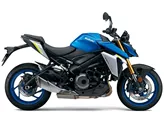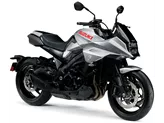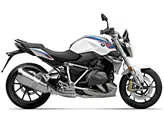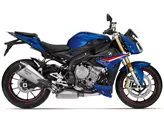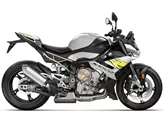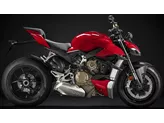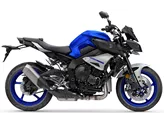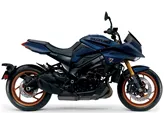BMW S 1000 R 2016 vs. Suzuki GSX-S1000 2018

BMW S 1000 R 2016

Suzuki GSX-S1000 2018
Overview - BMW S 1000 R 2016 vs Suzuki GSX-S1000 2018
The BMW S 1000 R 2016 and the Suzuki GSX-S1000 2018 are both naked bikes with similar engine types, displacements, and suspension systems. However, there are some notable differences between the two models.
In terms of engine power, the BMW S 1000 R 2016 has a slight advantage with 160 HP compared to the Suzuki GSX-S1000 2018's 149 HP. This extra power can provide a more thrilling and exhilarating riding experience on the BMW. Additionally, the BMW has a higher torque of 112 Nm compared to the Suzuki's 106 Nm, which can contribute to better acceleration and responsiveness.
Both bikes have four cylinders and a displacement of 999cc, ensuring a strong and smooth performance. The front suspension on both models is an upside-down telescopic fork, providing stability and control during cornering and braking. The rear suspension is a swing arm with a monoshock, further enhancing the bikes' handling capabilities.
In terms of chassis, both bikes feature an aluminum frame with a twin-tube design. This construction helps to keep the bikes lightweight while maintaining strength and rigidity. The BMW S 1000 R 2016 has a slightly lighter curb weight of 207 kg compared to the Suzuki GSX-S1000 2018's 209 kg, which can contribute to better maneuverability and agility.

BMW S 1000 R 2016
Both bikes have double disk front brakes with four pistons and radial technology, ensuring powerful and responsive braking performance. The Suzuki GSX-S1000 2018 comes with ABS as standard, providing an added safety feature. On the other hand, the BMW S 1000 R 2016 offers advanced rider assistance systems, including dynamic suspension, which can enhance the overall riding experience and comfort.
In terms of dimensions, the Suzuki GSX-S1000 2018 has a slightly longer wheelbase of 1460 mm compared to the BMW S 1000 R 2016's 1439 mm. This can contribute to better stability and handling at high speeds. Both bikes have similar front and rear tire widths and diameters, ensuring good traction and grip on the road.
The seat height on both models is relatively similar, with the Suzuki having a slightly higher seat height of 815 mm compared to the BMW's 814 mm. This may result in a slightly more upright riding position on the Suzuki.

Suzuki GSX-S1000 2018
In terms of fuel tank capacity, the BMW S 1000 R 2016 has a slightly larger tank with a capacity of 17.5 liters compared to the Suzuki GSX-S1000 2018's 17 liters. This can provide a slightly longer range between refueling stops.
In terms of strengths, the BMW S 1000 R 2016 is praised for its powerful and well-controllable engine, powerful braking system, and comfortable seating position. On the other hand, the Suzuki GSX-S1000 2018 is commended for its stable handling, sporty engine, attractive appearance, pleasant riding comfort, and dynamic yet serene riding experience.
In terms of weaknesses, the BMW S 1000 R 2016 is criticized for its expensive optional extras and a hard chassis. The Suzuki GSX-S1000 2018 is noted to be a little jerky when changing from push to load and could benefit from a quickshifter with a blipper.
Overall, both the BMW S 1000 R 2016 and the Suzuki GSX-S1000 2018 offer powerful and capable naked bikes with their own unique strengths and weaknesses. The choice between the two ultimately depends on the rider's preferences and priorities.
Technical Specifications BMW S 1000 R 2016 compared to Suzuki GSX-S1000 2018
Pros and Cons in comparison
Pros and Cons in comparison
BMW S 1000 R 2016

With the BMW S 1000 R, you notice both the close relationship to the S 1000 RR superbike and the endeavour to equip the machine with a high degree of comfort for country roads and everyday use. Accordingly, the 1000cc four-cylinder power unit is brute and yet easily controllable, and the seating position is correspondingly sporty and comfortable. The fact that the S 1000 R is one of the most affordable power naked bikes is surprising and very pleasing, although one must not get hold of the list of optional extras - because thanks to the many irresistible features, it will certainly be more expensive.
Suzuki GSX-S1000 2018

The GSX-S 1000 from Suzuki looks sexy, has a powerful sound and really smart hardware. It rides stably, easily and is also fun to ride on tours. If necessary, the engine smokes up violently. But it can also be moved mildly. Compared to the finest Powernakeds, it lacks individual features, but anyone who looks at the price tag will quickly realise: A great choice!
Price Comparison Avarage Market Price BMW S 1000 R vs Suzuki GSX-S1000
There are a few key differences between a BMW S 1000 R 2016 and a Suzuki GSX-S1000 2018. In terms of price, the actual average price of a BMW S 1000 R 2016 is about 18% higher. A BMW S 1000 R 2016 experiences a loss of 380 USD in one year and 1,940 USD in two years of ownership. This is offset by a loss of 270 USD and 1,010 USD for a Suzuki GSX-S1000 2018. Compared to Suzuki GSX-S1000 2018 there are more BMW S 1000 R 2016 bikes available on the 1000PS.de Marketplace, specifically 10 compared to 9. It takes less time to sell a BMW S 1000 R with 69 days compared to 177 days for a Suzuki GSX-S1000. Since model year 2014 1000PS.de editors have written 62 reviews for the BMW S 1000 R and 36 reviews for the Suzuki GSX-S1000 since model year 2015. The first review for the BMW S 1000 R was published on 11/3/2013 and now has more than 17,300 views. This compares to more than 17,100 views for the first review on Suzuki GSX-S1000 published on 9/27/2014.


